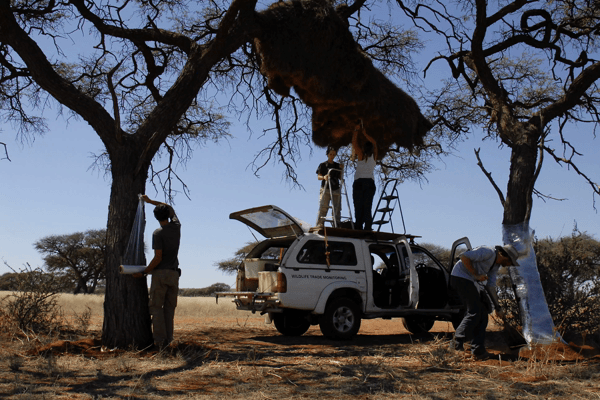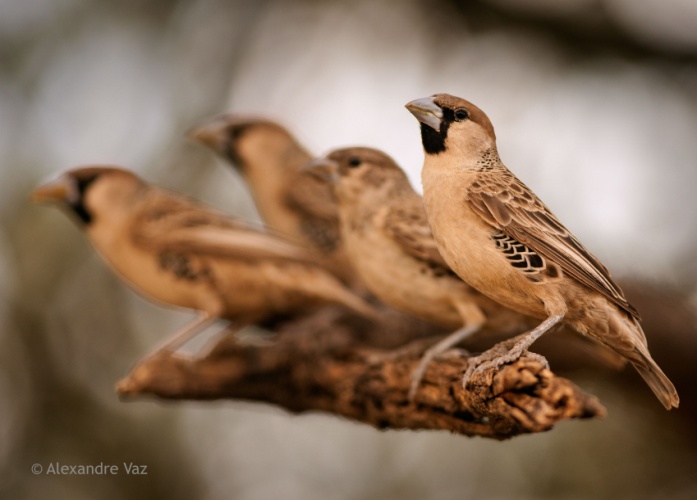This blog post is provided by Rita Fortuna and tells the #StoryBehindThePaper for the article “Maternal allocation in relation to weather, predation and social factors in a colonial cooperative bird“, which was recently published in Journal of Animal Ecology.
For almost a decade, we weighed over 9,000 sociable weaver eggs (Philetairus socius). Behind this paper, as with every long-term study, is an incredible amount of people, work, resources and motivation.
I. Motivation
Sociable weavers are intriguing birds. They are known for building communally the largest nest structure in the avian world, their ‘colonies’, where hundreds of individuals can live. In these colonies, breeding pairs and their helpers breed cooperatively. Having helpers sounds great: they feed the chicks, build the nest, and even clean it. But why do these birds help? And what are the consequences of living in this highly social system? These are the main questions behind everyone’s work in the Sociable Weaver Project.
I joined the project in 2015, but the audacious idea of weighing thousands of eggs to study sociable weavers’ reproductive strategies came up years before, in 2009. The studies of Barbara Taborsky (Taborsky et al., 2007), Andy Russell (Russell et al., 2007) and respective co-authors on concealed helper effects had just been published, and Rita Covas and Claire Doutrelant, our project leaders, were re-establishing the sociable weaver research project in South Africa. Rita and Claire brainstormed about collecting reproductive investment data in sociable weavers while doing research at the American Museum of Natural History. In between museum specimen measurements, they applied for a grant to study helper effects on maternal allocation along several breeding seasons. Collecting this data would contribute to further test the hypothesis that females lay smaller eggs when they breed with more helpers, and thus unravel some hidden benefits of cooperative breeding. Were breeding females getting the best out of it? That grant application got funded and Matthieu Paquet, at the time a PhD candidate, started working on this question. Matthieu analysed egg mass data from one season and found evidence for the same effect(Paquet et al., 2013) that had been described in other systems: sociable weaver females appeared to be saving energy by investing less in their eggs when breeding with helpers. Exciting! Now we had the rare opportunity to study if this helper effect was detectable across years, which is especially important in these types of environment where ecological and social conditions can vary so much.
II. Work and resources
It was only in 2017 – 8 years after the initial brainstorming – that we revisited this question. In the meantime, four research grants and sustained funding from the FitzPatrick Institute of African Ornithology allowed us to continue collecting data for this study. The importance of long-term studies is well recognised (Cockburn, 2014), but finding resources to keep them going for years, with no immediate scientific output, can be quite challenging. The expenses and the challenges are even greater when your study species can breed for 10 months or longer, as sociable weavers often do!
We monitored a total of 3,418 nests and weighed 9,120 eggs over those 9 years. Every morning, field teams would visit the colonies, inspecting every nest, until one egg was found. From that day on, we could plan to weigh the clutch 2 days later and to check that nest until all eggs were laid. We could also estimate hatching dates and plan video recordings of nestling feeding. These videos allowed us to determine the number of helpers in females’ groups, and thus to study how the same mother, as she gained and lost helpers, allocated resources to egg mass and clutch size.
It is hard to breed in the arid savanna, but the resilience of these birds never ceases to amaze us. Besides the harsh climate, sociable weavers face a problem for breeding success that we could not overlook: nest predation. Snakes can depredate around 70% of the breeding attempts (Covas et al., 2008) and some females lay over a dozen replacement clutches. To experimentally manipulate predation, we wrapped some of the colony trees with plastic cling film, which prevented snakes from reaching the nests. This way, we could study how removing nest-predation pressure affects egg-laying decisions.



III. People
For the duration of this study (2008-2017), more than 30 people conducted nest-monitoring fieldwork with the Sociable Weaver Project, at Benfontein Nature Reserve. This number is even higher when including our annual winter captures, where groups of at least 10 people get together for 15-20 days to capture the entire monitored population. This continuous data collection is the basis of all our analyses. Here, it allowed us not only to estimate mothers’ breeding investment, but also to include information about the size and age of the female, the number of clutches she had previously laid or how the size of her colony changed throughout the years.
As a researcher new to long-term analyses, I certainly underestimated the time it takes to compile all this information – breeding data, video recordings, annual captures, genetic analyses, etc. – even when this task is shared. Thus, the collaborative work of all authors was essential to bring this study together. Behind this paper are the experience and experimental design work of Rita and Claire, Matthieu’s knowledge from his studies on maternal effects, Franck’s commitment to our long-term data collection, Liliana’s flawless video analyses and the time that she and André dedicated to compile our behavioural and parentage databases.
So, are breeding females getting the best out of it?
Contrary to what we found in a 1-year study (Paquet et al., 2013), our long-term analysis revealed no effect of helpers on how each sociable weaver female adjusts egg mass, or even clutch size. In fact, egg mass varied quite consistently within females, suggesting that mothers may not have much advantage or capacity to adjust it. These findings challenge what we know about egg investment strategies in cooperative systems (Dixit et al., 2017), since we now find no general tendency for a concealed helpers’ effect across species. Nevertheless, our results confirmed that ecological conditions are important for these birds’ reproductive strategies. Mothers laid larger clutches after more rainfall and in colonies protected from snakes, which could be opportunistic ways of getting the best out of their breeding environment, and maximise reproductive success.
References
Cockburn, A. (2014). Behavioral ecology as big science: 25 years of asking the same questions. Behavioral Ecology, 25(6), 1283–1286. https://doi.org/10.1093/beheco/aru177
Covas, R., du Plessis, M. a., & Doutrelant, C. (2008). Helpers in colonial cooperatively breeding sociable weavers Philetairus socius contribute to buffer the effects of adverse breeding conditions. Behavioral Ecology and Sociobiology, 63(1), 103–112. https://doi.org/10.1007/s00265-008-0640-2
Dixit, T., English, S., & Lukas, D. (2017). The relationship between egg size and helper number in cooperative breeders: A meta-analysis across species. PeerJ, 5, e4028. https://doi.org/10.7717/peerj.4028
Paquet, M., Covas, R., Chastel, O., Parenteau, C., & Doutrelant, C. (2013). Maternal Effects in Relation to Helper Presence in the Cooperatively Breeding Sociable Weaver. PLoS ONE, 8(3). https://doi.org/10.1371/journal.pone.0059336
Russell, A. F., Langmore, N. E., Cockburn, A., Astheimer, L. B., & Kilner, R. M. (2007). Reduced egg investment can conceal helper effects in cooperatively breeding birds. Science (New York, N.Y.), 317(5840), 941–944. https://doi.org/10.1126/science.1146037
Taborsky, B., Skubic, E., & Bruintjes, R. (2007). Mothers adjust egg size to helper number in a cooperatively breeding cichlid. Behavioral Ecology, 18(4), 652–657. https://doi.org/10.1093/beheco/arm026



